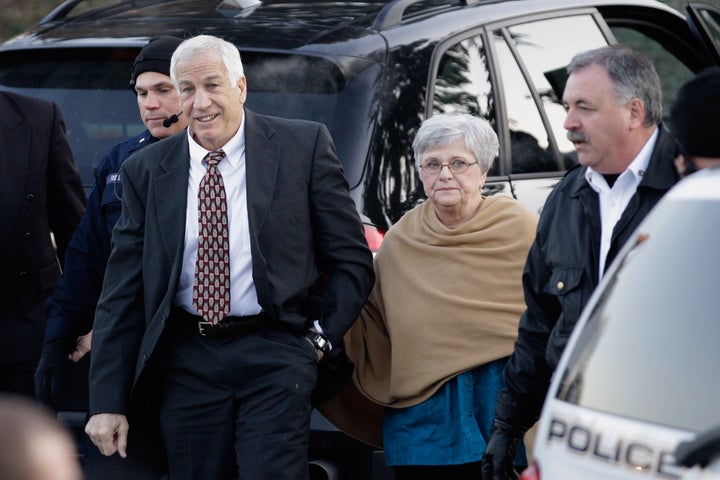
 This article was co-authored with Pamela Mejia. Mejia is a Research Associate at the Berkeley Media Studies Group, where she analyzes how the media talks about public health and social issues. She was a lead author on "Breaking News on Child Sexual Abuse."
This article was co-authored with Pamela Mejia. Mejia is a Research Associate at the Berkeley Media Studies Group, where she analyzes how the media talks about public health and social issues. She was a lead author on "Breaking News on Child Sexual Abuse."
People are still talking about Penn State. This week, a judge released the time frame for the events leading up to the trial of former defensive coach Jerry Sandusky. His arrest last November triggered a wave of news coverage. But what is the media coverage saying, and how might it affect the public conversation as Sandusky's trial moves forward?
A new study, Breaking news on child sexual abuse: Early coverage of Penn State by the Berkeley Media Studies Group, commissioned by the Ms. Foundation for Women analyzed the first nine days of coverage. The study found gaps in reporting that should be fixed so that news coverage reaches past a single case to investigate how to prevent child sexual abuse, including what institutions can do.
The Bad News
There is room for journalists to improve their coverage. For one thing, though more than half of the news and general coverage introduced the idea that Penn State University bore institutional responsibility for the abuse, the great majority of the coverage focused on Sandusky's culpability. As we discussed in an earlier Huffington Post column, coverage that focuses on the 'bad guy' misses the point that institutions were using their power to silence the scandal and were in large part responsible for the sexual abuse continuing and the large number of victims.
Where are the survivors? The survivors themselves were almost entirely absent from the coverage. Instead, former head football coach Joe Paterno dominated -- the news talked about him more than any other figure, and the coverage was overwhelmingly laudatory. In fact, the coverage was over three times as likely to discuss the consequences of the allegations for Paterno, as it was to talk about the consequences for the survivors.
Where was prevention? Finally, and perhaps most critically, solutions to child sexual abuse and discussion of prevention were virtually non-existent in the coverage. Stories like this are important for opening up the issue, but news coverage is still are not yet talking about ways to prevent children from being abused, and how institutions themselves bear responsibility for perpetuating -- or reducing -- incidents of child sexual abuse.
The Good News
Sports reporters get the story. The news coverage of the Sandusky case attracted many sports writers to the issue, some of whom were likely covering the topic for the first time. Almost one half (48%) of the initial coverage appeared in the sports sections. Child sexual abuse shouldn't just be relegated to the crime section -- especially when coaches and other sports professionals are involved.
Much reporting calls a rape a rape. Though Sandusky and his lawyer notoriously tried to downplay the allegations with phrases like "horsing around," most of the news avoided repeating this minimizing language, and instead used phrases like "rape," "sexual abuse," and "sexual assault." In cases of child sex abuse, when the news media doesn't "soft pedal the enormity of the abuse perpetrated," readers have a clearer picture of what the survivors experienced, and may better understand why prevention is critical.
Reporters -- and their sources, advocates for prevention -- can do better.
The media spotlight won't shift from Sandusky and Penn State anytime soon: journalists and advocates can take advantage of this opportunity to work to improve the coverage of child sexual abuse, and expand it to push for policies that will institute prevention.
Reporters can keep the issue on the sports pages and elsewhere in the news. The Penn State scandal is just the most recent and public instance of a crime that happens every day, one that, according to the Philadelphia Children's Alliance, "flourishes in secrecy." To help end that secrecy, keep the spotlight on the issue beyond the current news cycle. Explore other sports stories on child sexual abuse: Investigate what coaches, teams, and schools are doing to make sure it doesn't happen in their institution. Reporters need to shine a light on our accepting environment, expose the norm that child sexual abuse is an every day occurrence, and cover institutional and policy changes that would better support victims and penalize cover ups. Their stories need to show that young people are more important than sports heroes.
Advocates can release their comments to the media quickly. Many of the statements released by advocacy groups did not appear in the media until well after the first week of coverage and therefore could not be quoted by journalists as the story broke. If prevention advocates want to contribute to breaking news, they will need to respond faster and let reporters know what sorts of information and insights they can bring to a story.
Advocates and reporters can push for solutions. Advocates can suggest policies and programs that can shift the focus to prevention. Reporters can talk to advocates, researchers, policy makers and others in authority and push them for answers to these and other important questions about how to prevent future abuse. Reporters should ask: "What can we do to prevent another Penn State?" "What are communities already doing?"
Media coverage of the tragedies that occurred at Penn State has helped open unprecedented and vital conversations about child sexual abuse. As the story continues to unfold, journalists and advocates have a unique opportunity to shift the conversation to what can be done to make sure it doesn't happen again.